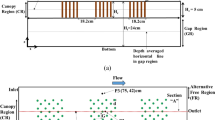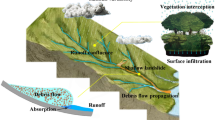Abstract
Landslide dams in mountainous areas are quite common. Typically, intense rainfalls can induce upstream flows along the sloping channel, which greatly affects the stability and failure modes of landslide dams. If a series of landslide dams are sequentially collapsed by an incoming mountain torrent (induced by intense rainfall), large debris flows can be formed in a short period of time. This also amplifies the magnitude of the debris flows along the flow direction. The catastrophic debris flows, which occurred in Zhouqu, China on August 8, 2010, were indeed caused by intense rainfall and the upstream cascading failure of landslide dams along the gullies. Experimental tests were conducted in a sloping channel to understand the dynamic process of cascading landslide dam failures and their effect on flow scale amplification. Similar to the Zhouqu conditions, the modeled landslide dams were distributed along a sloping channel and breached by different upstream flows. For each experiment, the front flows were sampled, the entrained grain sizes were analyzed, and the front discharge along the channel was measured. The results of these experiments show that landslide dams occurring along the channel can be destroyed by both high and low discharge flows, although the mechanisms are quite different for the two flow types. Regardless of flow type, the magnitude of the flows significantly increases after a cascading failure of landslide dams, resulting in an increase in both the diameter and the entrained coarse particles percentage.














Similar content being viewed by others
References
Chang DS, Zhang LM (2010) Simulation of the erosion process of landslide dams due to overtopping considering variations in soil erodibility along depth. Nat Hazards Earth Syst Sci 10(4):933–946
Chang DS, Zhang LM, Xu Y, Huang RQ (2011) Field testing of erodibility of two landslide dams triggered by the 12 May Wenchuan earthquake. Landslides 8(3):321–332
Chen CC, Chen TC, Yu FC, Hung FY (2004) A landslide dam breach induced debris flow—a case study on downstream hazard areas delineation. Environ Geol 47:91–101
Cleary PW, Prakash M (2004) Discrete-element modelling and smoothed particle hydrodynamics: potential in the environmental sciences. Philos Trans R Soc A Math Phys Eng Sci 362(1822):2003–2030
Corominas J, Moya J (2008) A review of assessing landslide frequency for hazard zoning purposes. Eng Geol 102(3–4):193–213
Costa JE (1985) Floods from dam failures. United States Geological Survey open-file report 85-560
Costa JE, Schuster RL (1988) Formation and failure of natural dams. Bull Geol Soc Am 100(7):1054–1068
Crosta GB, Clague JJ (2009) Dating, triggering, modelling, and hazard assessment of large landslides. Geomorphology 103(1):1–4
Cui P, Zhu YY, Han YS, Chen XQ, Zhuang JQ (2009) The 12 May Wenchuan earthquake-induced landslide lakes: distribution and preliminary risk evaluation. Landslides 6:209–223
Davies TRH (1986) Large debris flows: a macro-viscous phenomenon. Acta Mech 63:161–178
Dong JJ, Tung YH, Chen CC, Liao JJ, Pan YW (2009) Discriminant analysis of the geomorphic characteristics and stability of landslide dams. Geomorphology 110:162–171
Dong JJ, Li YS, Kuo CY, Sung RT, Li MH, Lee CT, Chen CC, Lee WR (2011) The formation and breach of a short-lived landslide dam at Hsiaolin village, Taiwan—part I: post-event reconstruction of dam geometry. Eng Geol 123(1-2):40–59
Dunning SA, Armitage PJ (2011) The grain-size distribution of rock-avalanche deposits: implications for natural dam stability. In: Evans SG, Hermanns RL, Strom A, Scarascia-Mugnozza G (eds) Natural and artificial rockslide dams. Lect Notes Earth Sci 133: 479–498
Ermini L, Casagli N (2003) Prediction of the behaviour of landslide dams using a geomorphological dimensionless index. Earth Surf Process Landforms 28(1):31–47
Hewitt K (1998) Catastrophic landslides and their effects on the Upper Indus streams, Karakoram Himalaya, northern Pakistan. Geomorphology 26:47–80
Hovius N, Stark CP, Allen PA (1997) Sediment flux from a mountain belt derived from landslide mapping. Geology 25:231–234
Hovius N, Stark CP, Tutton MA, Abbott LD (1998) Landslide-driven drainage network evolution in a pre-steady-state mountain belt: Finisterre Mountains, Papua New Guinea. Geology 26:1071–1074
Hu KH, Ge YG, Cui P, Guo XJ, Yang W (2010) Preliminary analysis of extra-large-scale debris flow disaster in Zhouqu County of Gansu Province. J Mt Sci (Chinese) 05:628–634
Iovine G, Gregorio SD, Sheridan MF, Miyamoto H (2007) Modelling, computer-assisted simulations, and mapping of dangerous phenomena for hazard assessment. Environ Model Softw 22(10):1389–1391
Iverson RM (1997) The physics of debris flows. Rev Geophys 35(3):245–296
Kasai M, Marutani T, Brierley G (2004) Channel bed adjustments following major aggradation in a steep headwater setting: findings from Oyabu Creek, Kyushu, Japan. Geomorphology 62(3-4):199–215
Keefer DK (1999) Earthquake-induced landslides and their effects on alluvial fans. J Sediment Res 69(1):84–104
Koi T, Hotta N, Ishigaki I, Matuzaki N, Uchiyama Y, Suzuki M (2008) Prolonged impact of earthquake-induced landslides on sediment yield in a mountain watershed: the Tanzawa region, Japan. Geomorphology 101(4):692–702
Korup O (2002) Recent research on landslide dams—a literature review with special attention to New Zealand. Prog Phys Geogr 26(2):206–235
Korup O (2004) Geomorphometric characteristics of New Zealand landslide dams. Eng Geol 73:13–35
Korup O (2005) Geomorphic hazard assessment of landslide dams in South Westland, New Zealand: fundamental problems and approaches. Geomorphology 66(1–4 SPEC. ISS):167–188
Korup O, McSaveney MJ, Davies TRH (2004) Sediment generation and delivery from large historic landslides in the Southern Alps, New Zealand. Geomorphology 61(1–2):189–207
Korup O, Strom AL, Weidinger JT (2006) Fluvial response to large rock-slope failures—examples from the Himalayas, the Tien Shan, and the New Zealand Southern Alps. Geomorphology 78:3–21
Korup O, Densmore AL, Schlunegger F (2010) The role of landslides in mountain range evolution. Geomorphology 120(1-2):77–90
Li MH, Hsu MH, Hsieh LS, Teng WH (2002) Inundation potentials analysis for Tsao-Ling landslide lake formed by Chi-Chi earthquake in Taiwan. Nat Hazard 25:289–303
Li MH, Sung RT, Dong JJ, Lee CT, Chen CC (2011) The formation and breaching of a short-lived landslide dam at Hsiaolin Village, Taiwan—part II: simulation of debris flow with landslide dam breach. Eng Geol 123(1-2):60–71
Ma DT (2010) Some suggestions on controlling catastrophic debris flows on Aug. 8th, 2010 in Zhouqu, Gansu. J Mt Sci (Chinese) 05:635–640
Nandi A, Shakoor A (2009) A GIS-based landslide susceptibility evaluation using bivariate and multivariate statistical analyses. Eng Geol 110:11–20
Ouimet WB, Whipple KX, Royden LH, Sun Z, Chen Z (2007) The influence of large landslides on river incision in a transient landscape: eastern margin of the Tibetan Plateau (Sichuan, China). Bull Geol Soc Am 119(11–12):1462–1476
Peng M, Zhang LM (2012) Breaching parameters of landslide dams. Landslides 9:13–31
Plafker G, Ericksen GE (1978) Nevado Huascaran avalanches, Peru. In: Voight B (ed) Rockslides and avalanches, vol 1, Natural phenomena. Elsevier, New York, pp 277–314
Schwab M, Rieke-Zapp D, Schneider H, Liniger M, Schlunegger F (2008) Landsliding and sediment flux in the Central Swiss Alps: a photogrammetric study of the Schimbrig landslide, Entlebuch. Geomorphology 97(3–4):392–406
Scott KM, Vallance JW, Pringle PT (1995) Sedimentology, behavior, and hazards of debris flows at Mount Rainier, Washington. US Geol Surv Prof Pap 1547:56
Strasser M, Schlunegger F (2005) Erosional processes, topographic length-scales and geomorphic evolution in arid climatic environments: the “Lluta collapse”, northern Chile. Int J Earth Sci 94:433–446
Swanson FJ, Oyagi N, Tominaga M (1986) Landslide dams in Japan. In: RL Schuster (ed) Landslide dams: processes, risk, and mitigation. American Society of Civil Engineers, Geotechnical Special Publication 3: 131–145
Tang C, Rengers N, Van Asch TWJ, Yang YH, Wang GF (2011) Triggering conditions and depositional characteristics of a disastrous debris flow event in Zhouqu city, Gansu Province, northwestern China. Nat Hazards Earth Syst Sci 11(11):2903–2912
Walder JS, O’Connor JE (1997) Methods for predicting peak discharge of floods caused by failure of natural and constructed earthen dams. Water Resour Res 33(10):2337–2348
Yalin MS (1971) Theory of hydraulic models. Macmillan, Oxford
Yu B, Yang YH, Su YC, Huang WJ, Wang GF (2010) Research on the giant debris flow hazards in Zhouqu county, Gansu Province on August 7, 2010. J Eng Geol 04:437–444
Zhao YC, Cui CG (2010) A study of rainstorm process triggering Zhouqu extremely mudslide on 8 August 2010. Torrential Rain Disaster 9:289–295 (in Chinese)
Acknowledgments
The authors acknowledge financial support from the National Basic Research Program of China (973 Program) (grant no. 2011CB409902), the Key Program of National Natural Science Foundation of China (grant no. 41030742), and the Hundred Young Talents Program of the Institute of Mountain Hazards and Environment. The technical support from DDFORS is also gratefully acknowledged. Finally, the authors thank the two anonymous reviewers of this paper for the detailed remarks and helpful discussions.
Author information
Authors and Affiliations
Corresponding author
Rights and permissions
About this article
Cite this article
Zhou, G.G.D., Cui, P., Chen, H.Y. et al. Experimental study on cascading landslide dam failures by upstream flows. Landslides 10, 633–643 (2013). https://doi.org/10.1007/s10346-012-0352-6
Received:
Accepted:
Published:
Issue Date:
DOI: https://doi.org/10.1007/s10346-012-0352-6




